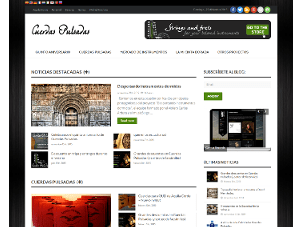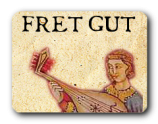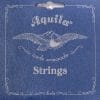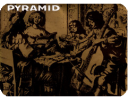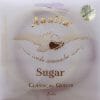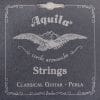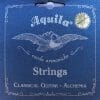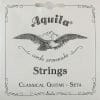This time we have an interview with Jota Martínez, one of the leading specialists in Spain on medieval instruments, in connection with his latest project: an anthology of musical instruments in the Western Middle Ages that consists of a book and more 130 minutes of music where you can find out the details of more than 150 instruments from the Spanish medieval tradition .
 Jota Martínez (Madrid, 1971). begins to specialize in the hurdy gurdy or viola wheel and historical and traditional percussion by the best specialists in Europe. Later she begins the study of plucked string instruments and specializes in medieval cytos and lutes. She also receives psaltery classes given by Begoña Olavide.
He has collaborated as a multi-instrumentalist of medieval, renaissance and baroque music in early music groups such as Figurative Singing, Choral Alfonso X el Sabio, Early Music Eduardo Paniagua, Capella de Ministrers, Axivil, Al Andaluz Project, Ensemble Diatessaron, Ensemble Xácara or Ensemble L´ Happiness. Currently conducting the ensemble that accompanies Mara Aranda and also his own, specializing in Spanish medieval music and instruments from the three cultures.
In her more than 20 years of professional career, she has traveled the five continents and has become an ambassador for Spanish medieval instruments. She has participated in the recording of more than 40 discs on old peninsular music.
Since 2005 she composes, records and produces music for documentaries, short films and musicals in her own studio, “Pilgrim Records”, specialized in old and root music.
Jota has opted for a crowdfunding model to finance the last stage of this unique project: a study of the instruments of the peninsular medieval tradition based on his experience in the reconstruction, collection and study of the instruments of the time.
The book is made up of more than 240 pages, 200 of them, in full color, with the iconographic images and photographs of the reconstructions. All this, perfectly ordered for easy consultation, reading and understanding.
The publication is accompanied by 2 CDs of Spanish music of the time: 130 minutes spread over 29 works in which Jota Martínez has formed small ensembles that play Spanish music of the time, thus demonstrating that all the reconstructed instruments fulfill the function for the They were originally designed, each one with its own possibilities, and also showing how the sound of these instruments could be, many of them unknown and some already in disuse.
We encourage you to collaborate so that this project achieves the proposed goal.
Jota Martínez (Madrid, 1971). begins to specialize in the hurdy gurdy or viola wheel and historical and traditional percussion by the best specialists in Europe. Later she begins the study of plucked string instruments and specializes in medieval cytos and lutes. She also receives psaltery classes given by Begoña Olavide.
He has collaborated as a multi-instrumentalist of medieval, renaissance and baroque music in early music groups such as Figurative Singing, Choral Alfonso X el Sabio, Early Music Eduardo Paniagua, Capella de Ministrers, Axivil, Al Andaluz Project, Ensemble Diatessaron, Ensemble Xácara or Ensemble L´ Happiness. Currently conducting the ensemble that accompanies Mara Aranda and also his own, specializing in Spanish medieval music and instruments from the three cultures.
In her more than 20 years of professional career, she has traveled the five continents and has become an ambassador for Spanish medieval instruments. She has participated in the recording of more than 40 discs on old peninsular music.
Since 2005 she composes, records and produces music for documentaries, short films and musicals in her own studio, “Pilgrim Records”, specialized in old and root music.
Jota has opted for a crowdfunding model to finance the last stage of this unique project: a study of the instruments of the peninsular medieval tradition based on his experience in the reconstruction, collection and study of the instruments of the time.
The book is made up of more than 240 pages, 200 of them, in full color, with the iconographic images and photographs of the reconstructions. All this, perfectly ordered for easy consultation, reading and understanding.
The publication is accompanied by 2 CDs of Spanish music of the time: 130 minutes spread over 29 works in which Jota Martínez has formed small ensembles that play Spanish music of the time, thus demonstrating that all the reconstructed instruments fulfill the function for the They were originally designed, each one with its own possibilities, and also showing how the sound of these instruments could be, many of them unknown and some already in disuse.
We encourage you to collaborate so that this project achieves the proposed goal.
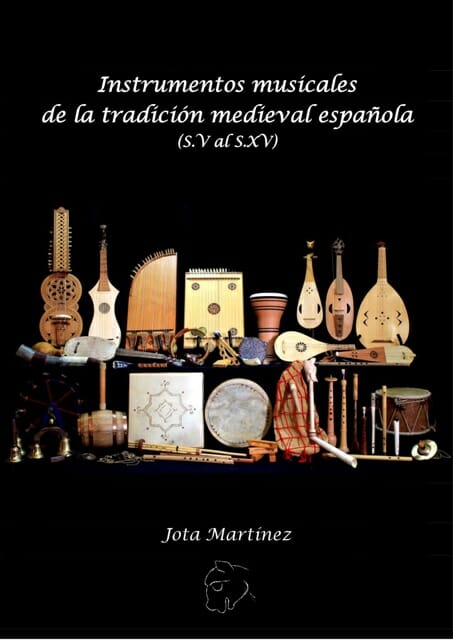 All this, and my self-commitment to publicize this part of our heritage, encouraged me to make this project come true.
In addition, I want to emphasize that, for me, it is not just a project, but a way of life. And as my knowledge and experience will continue to grow, so will this collection of instruments.
All this, and my self-commitment to publicize this part of our heritage, encouraged me to make this project come true.
In addition, I want to emphasize that, for me, it is not just a project, but a way of life. And as my knowledge and experience will continue to grow, so will this collection of instruments.
 After having had many “folk” instruments, throughout my life, out of curiosity to try and experiment with them, I came into contact with Spanish old music playing with Eduardo Paniagua. At this moment, a new and seductive world in which I decided to enter.
At that time, very few had reconstructions of medieval instruments. Almost all of us made old music, with baroque and folk instruments. Little by little, I was getting instruments, sometimes bought and others built, which were reproductions of the instruments that were played in our Middle Ages. I imagine that all this, together with my curiosity and my multi-instrumentalist character, has made it more than 150 pieces that I have today.
After having had many “folk” instruments, throughout my life, out of curiosity to try and experiment with them, I came into contact with Spanish old music playing with Eduardo Paniagua. At this moment, a new and seductive world in which I decided to enter.
At that time, very few had reconstructions of medieval instruments. Almost all of us made old music, with baroque and folk instruments. Little by little, I was getting instruments, sometimes bought and others built, which were reproductions of the instruments that were played in our Middle Ages. I imagine that all this, together with my curiosity and my multi-instrumentalist character, has made it more than 150 pieces that I have today.
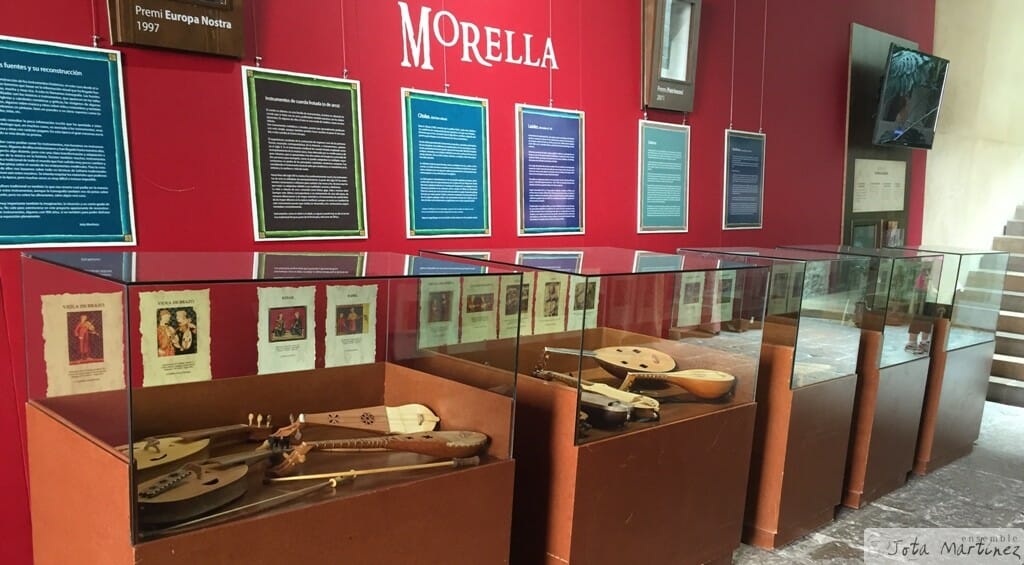 There is no furniture or decoration in the collection. They are all musical instruments. Each of them with their resources, greater or less, but all, with the possibility of sounding alone and together with others.
I have a program, for example, about music by minstrels and troubadours, in which we go to a duet, play 10 works, and always change instruments. In this way, we are accompanied by 20 instruments, which turn the concert into a small sound exhibition.
The same occurs with another program on Alfonso’s instruments, represented in the Cantigas de Santa María by Alfonso X “El sabio”, in which we accompany more than 40 instruments, which may come to sound during the concert, depending on the number of musicians on the stage.
There is no furniture or decoration in the collection. They are all musical instruments. Each of them with their resources, greater or less, but all, with the possibility of sounding alone and together with others.
I have a program, for example, about music by minstrels and troubadours, in which we go to a duet, play 10 works, and always change instruments. In this way, we are accompanied by 20 instruments, which turn the concert into a small sound exhibition.
The same occurs with another program on Alfonso’s instruments, represented in the Cantigas de Santa María by Alfonso X “El sabio”, in which we accompany more than 40 instruments, which may come to sound during the concert, depending on the number of musicians on the stage.
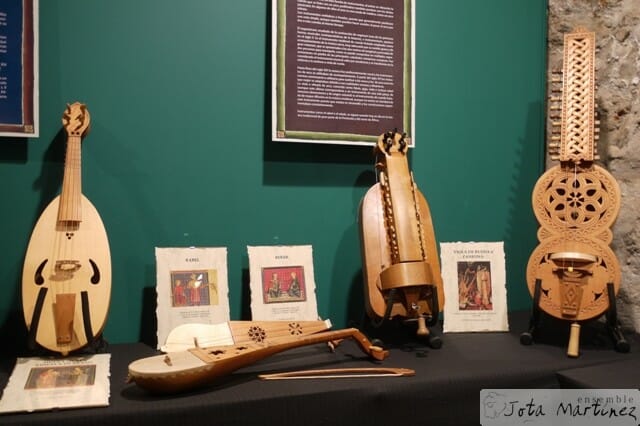 In the future, I would like all of them to be exposed in a place that can be visited and that would also serve to carry out other activities related to them, such as conferences, concerts, didactics, workshops, courses, etc. But that is already another project. Everything will go.
In the future, I would like all of them to be exposed in a place that can be visited and that would also serve to carry out other activities related to them, such as conferences, concerts, didactics, workshops, courses, etc. But that is already another project. Everything will go.
 The specialists in these musics and instruments, perhaps they find it poor of information and documentation, and surely, they are not going to discover anything new, beyond my opinion on some aspects and my interpretation of the musics and instruments.
But it should be borne in mind that there are already books and works related to all the instruments I speak of, and that there are people who have spent much of their lives focused on these studies. To be able to make a perfectly documented exhibition and with all the information known so far from such a large collection, a simple book falls short and would require a large encyclopedia in which, in addition, many specialists would work at the same time.
It is a book for lovers and fans of medieval instruments and music of their time, with an open mind and a desire for other proposals. And it is also a good book to start and begin to discover this exciting world, since I give many clues to continue studying and the bibliography used is very varied.
The specialists in these musics and instruments, perhaps they find it poor of information and documentation, and surely, they are not going to discover anything new, beyond my opinion on some aspects and my interpretation of the musics and instruments.
But it should be borne in mind that there are already books and works related to all the instruments I speak of, and that there are people who have spent much of their lives focused on these studies. To be able to make a perfectly documented exhibition and with all the information known so far from such a large collection, a simple book falls short and would require a large encyclopedia in which, in addition, many specialists would work at the same time.
It is a book for lovers and fans of medieval instruments and music of their time, with an open mind and a desire for other proposals. And it is also a good book to start and begin to discover this exciting world, since I give many clues to continue studying and the bibliography used is very varied.
 In some works the instruments fulfill the same function as in their time. In others I have collected instruments that appear together in the same representation. Other times I interpret the work with the instruments that appear in the same codex or manuscript and even on several occasions the instrument plays music written on the same page where it is drawn.
There is religious and popular music. Written, improvised and orally transmitted music. And practically the most important peninsular songbooks and codices of the time are represented.
I thought it appropriate to represent the Andalusian and Sephardic music, with which we share the heritage of this medieval Spanish tradition and as a tribute to this Spain expelled and settled throughout the Mediterranean, in which we can still see the echoes of ten centuries of history reflected in common.
In some works the instruments fulfill the same function as in their time. In others I have collected instruments that appear together in the same representation. Other times I interpret the work with the instruments that appear in the same codex or manuscript and even on several occasions the instrument plays music written on the same page where it is drawn.
There is religious and popular music. Written, improvised and orally transmitted music. And practically the most important peninsular songbooks and codices of the time are represented.
I thought it appropriate to represent the Andalusian and Sephardic music, with which we share the heritage of this medieval Spanish tradition and as a tribute to this Spain expelled and settled throughout the Mediterranean, in which we can still see the echoes of ten centuries of history reflected in common.
 Jota Martínez (Madrid, 1971). begins to specialize in the hurdy gurdy or viola wheel and historical and traditional percussion by the best specialists in Europe. Later she begins the study of plucked string instruments and specializes in medieval cytos and lutes. She also receives psaltery classes given by Begoña Olavide.
He has collaborated as a multi-instrumentalist of medieval, renaissance and baroque music in early music groups such as Figurative Singing, Choral Alfonso X el Sabio, Early Music Eduardo Paniagua, Capella de Ministrers, Axivil, Al Andaluz Project, Ensemble Diatessaron, Ensemble Xácara or Ensemble L´ Happiness. Currently conducting the ensemble that accompanies Mara Aranda and also his own, specializing in Spanish medieval music and instruments from the three cultures.
In her more than 20 years of professional career, she has traveled the five continents and has become an ambassador for Spanish medieval instruments. She has participated in the recording of more than 40 discs on old peninsular music.
Since 2005 she composes, records and produces music for documentaries, short films and musicals in her own studio, “Pilgrim Records”, specialized in old and root music.
Jota has opted for a crowdfunding model to finance the last stage of this unique project: a study of the instruments of the peninsular medieval tradition based on his experience in the reconstruction, collection and study of the instruments of the time.
The book is made up of more than 240 pages, 200 of them, in full color, with the iconographic images and photographs of the reconstructions. All this, perfectly ordered for easy consultation, reading and understanding.
The publication is accompanied by 2 CDs of Spanish music of the time: 130 minutes spread over 29 works in which Jota Martínez has formed small ensembles that play Spanish music of the time, thus demonstrating that all the reconstructed instruments fulfill the function for the They were originally designed, each one with its own possibilities, and also showing how the sound of these instruments could be, many of them unknown and some already in disuse.
We encourage you to collaborate so that this project achieves the proposed goal.
Jota Martínez (Madrid, 1971). begins to specialize in the hurdy gurdy or viola wheel and historical and traditional percussion by the best specialists in Europe. Later she begins the study of plucked string instruments and specializes in medieval cytos and lutes. She also receives psaltery classes given by Begoña Olavide.
He has collaborated as a multi-instrumentalist of medieval, renaissance and baroque music in early music groups such as Figurative Singing, Choral Alfonso X el Sabio, Early Music Eduardo Paniagua, Capella de Ministrers, Axivil, Al Andaluz Project, Ensemble Diatessaron, Ensemble Xácara or Ensemble L´ Happiness. Currently conducting the ensemble that accompanies Mara Aranda and also his own, specializing in Spanish medieval music and instruments from the three cultures.
In her more than 20 years of professional career, she has traveled the five continents and has become an ambassador for Spanish medieval instruments. She has participated in the recording of more than 40 discs on old peninsular music.
Since 2005 she composes, records and produces music for documentaries, short films and musicals in her own studio, “Pilgrim Records”, specialized in old and root music.
Jota has opted for a crowdfunding model to finance the last stage of this unique project: a study of the instruments of the peninsular medieval tradition based on his experience in the reconstruction, collection and study of the instruments of the time.
The book is made up of more than 240 pages, 200 of them, in full color, with the iconographic images and photographs of the reconstructions. All this, perfectly ordered for easy consultation, reading and understanding.
The publication is accompanied by 2 CDs of Spanish music of the time: 130 minutes spread over 29 works in which Jota Martínez has formed small ensembles that play Spanish music of the time, thus demonstrating that all the reconstructed instruments fulfill the function for the They were originally designed, each one with its own possibilities, and also showing how the sound of these instruments could be, many of them unknown and some already in disuse.
We encourage you to collaborate so that this project achieves the proposed goal.
Jota, after your long career as a musician and collector, how did this project come about?It arises from the need to capture, in writing and sound, my experience in the process of investigation and recovery of the medieval instruments that were played here, in the Iberian Peninsula and in which I have been immersed since 2000. It is also a way of showing the collection of instruments that I treasure, the iconographic and literary sources from which I draw inspiration for reconstructions, and part of the knowledge acquired about the history of these instruments from the work of researchers, medievalists, musicologists and organologists.
 All this, and my self-commitment to publicize this part of our heritage, encouraged me to make this project come true.
In addition, I want to emphasize that, for me, it is not just a project, but a way of life. And as my knowledge and experience will continue to grow, so will this collection of instruments.
All this, and my self-commitment to publicize this part of our heritage, encouraged me to make this project come true.
In addition, I want to emphasize that, for me, it is not just a project, but a way of life. And as my knowledge and experience will continue to grow, so will this collection of instruments.
The collection of instruments that you have managed to gather during your musical career is impressive and, of course, unique, what led you to make it up?Since I was little, I have had a weakness for collecting objects that have something to do with each other and since I can remember, I have listened to music at home, thanks to my family. I imagine this was the beginning of everything. From a young age, I spent my pay to buy cassettes and immediately the sonic gadgets that had been immortalized in them began to attract my attention.
 After having had many “folk” instruments, throughout my life, out of curiosity to try and experiment with them, I came into contact with Spanish old music playing with Eduardo Paniagua. At this moment, a new and seductive world in which I decided to enter.
At that time, very few had reconstructions of medieval instruments. Almost all of us made old music, with baroque and folk instruments. Little by little, I was getting instruments, sometimes bought and others built, which were reproductions of the instruments that were played in our Middle Ages. I imagine that all this, together with my curiosity and my multi-instrumentalist character, has made it more than 150 pieces that I have today.
After having had many “folk” instruments, throughout my life, out of curiosity to try and experiment with them, I came into contact with Spanish old music playing with Eduardo Paniagua. At this moment, a new and seductive world in which I decided to enter.
At that time, very few had reconstructions of medieval instruments. Almost all of us made old music, with baroque and folk instruments. Little by little, I was getting instruments, sometimes bought and others built, which were reproductions of the instruments that were played in our Middle Ages. I imagine that all this, together with my curiosity and my multi-instrumentalist character, has made it more than 150 pieces that I have today.
Is it possible to visit this collection in an exhibition?At the moment, due to lack of other resources, it is an exhibition that works temporarily. I offer it as part of my projects, and on some occasions, there has been a programmer or institution that has wanted to have it set up for a short season. Most of the time the exhibition is part of my concert programs. Because it is important to note that all instruments fulfill the function for which they were designed, which is to make music.
 There is no furniture or decoration in the collection. They are all musical instruments. Each of them with their resources, greater or less, but all, with the possibility of sounding alone and together with others.
I have a program, for example, about music by minstrels and troubadours, in which we go to a duet, play 10 works, and always change instruments. In this way, we are accompanied by 20 instruments, which turn the concert into a small sound exhibition.
The same occurs with another program on Alfonso’s instruments, represented in the Cantigas de Santa María by Alfonso X “El sabio”, in which we accompany more than 40 instruments, which may come to sound during the concert, depending on the number of musicians on the stage.
There is no furniture or decoration in the collection. They are all musical instruments. Each of them with their resources, greater or less, but all, with the possibility of sounding alone and together with others.
I have a program, for example, about music by minstrels and troubadours, in which we go to a duet, play 10 works, and always change instruments. In this way, we are accompanied by 20 instruments, which turn the concert into a small sound exhibition.
The same occurs with another program on Alfonso’s instruments, represented in the Cantigas de Santa María by Alfonso X “El sabio”, in which we accompany more than 40 instruments, which may come to sound during the concert, depending on the number of musicians on the stage.
 In the future, I would like all of them to be exposed in a place that can be visited and that would also serve to carry out other activities related to them, such as conferences, concerts, didactics, workshops, courses, etc. But that is already another project. Everything will go.
In the future, I would like all of them to be exposed in a place that can be visited and that would also serve to carry out other activities related to them, such as conferences, concerts, didactics, workshops, courses, etc. But that is already another project. Everything will go.
Jota, could you explain what we can find in the book?Mainly iconographic and literary sources, some historical records, photographs of the reconstructions, a little history of the instruments, bibliography used, and on some occasions, my point of view as an interpreter on some issues, which are still unresolved. I think communication between theoretical scholars and practical scholars is very important, and I put it this way in the book. It is the best way to continue advancing and to understand a little better the function of these instruments and the music that was made with them. I am convinced that some of the issues that I raise will give rise to talk, and I think that the debate is positive. At no time do I want to take a chair on anything I present. It is a book, very visual. For me, the iconography is very important, and the work that has involved the compilation of all the images, although even today, there are many unable to share all this heritage and knowledge. Some images have had to be purchased, others have been generously ceded, and many of them, we have had to go to do on site.
Jota, how would you rate the book? Is it an encyclopedic work, of popularization?I consider it an outreach job. My projects always have a great educational load because they move in areas unknown to the majority and not entirely known to the minority related to these concerns. For me, it is not just music and musical instruments. It is also history and heritage. And of course, a way of understanding life, since the more you study the past, the better you understand who you are and why. We are a perfect mix, in my point of view, of many peoples and traditions that have passed through our lands. And that is something that I also want to transmit in the pages of the book and the works of the CDs that accompany them.
 The specialists in these musics and instruments, perhaps they find it poor of information and documentation, and surely, they are not going to discover anything new, beyond my opinion on some aspects and my interpretation of the musics and instruments.
But it should be borne in mind that there are already books and works related to all the instruments I speak of, and that there are people who have spent much of their lives focused on these studies. To be able to make a perfectly documented exhibition and with all the information known so far from such a large collection, a simple book falls short and would require a large encyclopedia in which, in addition, many specialists would work at the same time.
It is a book for lovers and fans of medieval instruments and music of their time, with an open mind and a desire for other proposals. And it is also a good book to start and begin to discover this exciting world, since I give many clues to continue studying and the bibliography used is very varied.
The specialists in these musics and instruments, perhaps they find it poor of information and documentation, and surely, they are not going to discover anything new, beyond my opinion on some aspects and my interpretation of the musics and instruments.
But it should be borne in mind that there are already books and works related to all the instruments I speak of, and that there are people who have spent much of their lives focused on these studies. To be able to make a perfectly documented exhibition and with all the information known so far from such a large collection, a simple book falls short and would require a large encyclopedia in which, in addition, many specialists would work at the same time.
It is a book for lovers and fans of medieval instruments and music of their time, with an open mind and a desire for other proposals. And it is also a good book to start and begin to discover this exciting world, since I give many clues to continue studying and the bibliography used is very varied.
What are the main aspects on which you focus the publication? The organological aspect? Musicological? The repertoire of the time?A bit of everything. I think that the joint work is the one that can lead us to more and better conclusions. Personally, I really like organology. I have really enjoyed the work of finding similar instruments in the folklore and traditions of the world. This has helped us on many occasions to know how to start building an instrument, in what way. It is also very important to know how to tune it, how to play it and the possibilities it can have within a consort, or as a soloist. Finding medieval instruments, still alive today, with little evolution, is difficult, but it is possible, and it gives you life if you are a harbinger of these ancient instruments. It also gives many clues to know the evolutions that some of the instruments had to make them more versatile and to discover why some disappeared due to their limitations or due to new fashions and ways of interpreting. About the specific repertoire of each of the instruments there are some allusions in the book. Not many, because there is a lot of ignorance due to lack of information and due to the difficulty many times of accessing this little information. But if some records have arrived in contemporary historical sources, which inform us of the function that some instruments had and even of who used them habitually. It is very interesting to discover that, in some cases, the function and type of interpreters remain the same, hundreds of years later.
Regarding the recording, with what help have you had to make the recordings?The original idea was to record everything live, but I soon realized how impractical it was to bring together a large number of specialists for reasons of schedule and economy. Many of the instruments, I have recorded, due to the ease of the technique, to be able to record on tracks, instrument by instrument and then mix everything. For the recording I have had great specialists in this type of instrument such as: Carles Magraner, Spyros Kaniaris, Ismael Cabero, Andrés Belmonte and Daniel Ferrando. The voice also has a main role, as a perfect and divine instrument, considered at the time, and an instrument to imitate or accompany, from the beginning of time. They have given me their voices: Carmen Botella, Mara Aranda, Pedro Víctor Lopez Messeguer and Albert Ortuño.
Jota, what is your proposal about the sound of instruments?I always try to make the instruments sound as close to what they could be in their time, but sometimes it is almost impossible due to not having the necessary materials and knowledge and, furthermore, we will never know what their sound really was. We can get closer, but it will always be a proposal without knowing if it is more or less successful than others, because there are several possibilities, and all are feasible. I have even reconstructed some instruments that we do not even know if they were musical instruments or not, because there is no type of information written about them and they did not survive in time, we only have the iconographic source. The popular instruments of the time and those that I define as “instruments that are not” also have their place on the records. The function and limitations of the instruments is something that I like to respect, so as not to turn them into modern instruments. That is already done and I am not interested. It must be borne in mind that the music and treatises that have come down to us lack much information. Most of the time, it is a melody, sometimes without measure and with doubtful intervals. This means that the interpreter has to make use of his experience with these musics and also of the intuition that comes from knowing more and more repertoire. My sonic fantasy consists of forming small consorts with the instruments and interpreting music from their own time, with the possibilities and limitations of each one of them. I have taken into account the sound, timbral and volume affinity between them. Also if they are instruments that are still played together today.
 In some works the instruments fulfill the same function as in their time. In others I have collected instruments that appear together in the same representation. Other times I interpret the work with the instruments that appear in the same codex or manuscript and even on several occasions the instrument plays music written on the same page where it is drawn.
There is religious and popular music. Written, improvised and orally transmitted music. And practically the most important peninsular songbooks and codices of the time are represented.
I thought it appropriate to represent the Andalusian and Sephardic music, with which we share the heritage of this medieval Spanish tradition and as a tribute to this Spain expelled and settled throughout the Mediterranean, in which we can still see the echoes of ten centuries of history reflected in common.
In some works the instruments fulfill the same function as in their time. In others I have collected instruments that appear together in the same representation. Other times I interpret the work with the instruments that appear in the same codex or manuscript and even on several occasions the instrument plays music written on the same page where it is drawn.
There is religious and popular music. Written, improvised and orally transmitted music. And practically the most important peninsular songbooks and codices of the time are represented.
I thought it appropriate to represent the Andalusian and Sephardic music, with which we share the heritage of this medieval Spanish tradition and as a tribute to this Spain expelled and settled throughout the Mediterranean, in which we can still see the echoes of ten centuries of history reflected in common.
Thank you very much for your time, Jota, and we hope that you will achieve the goal of publishing the book. We remind all of you how you can collaborate. Thank you!

